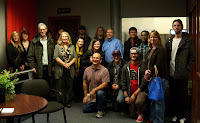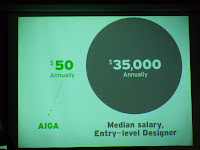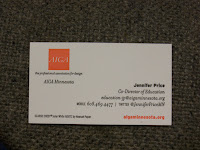This was our second trip of the day ... after the SHAPKO tour, coming to the ever known Walker Center was a bonus to our field trip...
The Walker Art Center.
We got a personal insight on printing and design value from Greg Beckel. He was patient and gave us a worthy time and explained a lot of their work in progress and work done in general. Some of the books there were simple awesome. I'd be more than happy if I could ever get to work here myself.
Nicole Bowden, Mel Campbell, Sturat Geddes, Natasha Ludowyk, Penelope Modra, Jeremy Wortsman.
Is Not Magazine, Young Is Not Free, issue 4, November 2005 Mel Campbell, Stuart Geddes, Natasha Ludowyk, Penelope Modra, Jeremy Wortsman.
Is Not Magazine, Love Is Not Lust, issue 1, April/May 2005 Courtesy the publisher.
Mel Campbell, Stuart Geddes,Natasha Ludowyk, Penelope Modra, Jeremy Worstman.
Is Not Magazine, All The Glitters In Not Gold, issue 11, July 2008 Courtesy the publisher.
Julia Bron and Laurenz Brunner: Title of the Show, 2009.
Created for the Museum of Contemporary Art, Leipzig, Germany, Title of the Show takes selections of Born's work-books, posters, postage stamps-and enlarges them on the gallery walls. The walls were then photographed, becoming the pages of the accompanying catalog. The printed catalog is on view in the book case (no. 87).
One of the best examples of Branding. Something I like to do.
Jonathan Barnbrook, 17th Biennale of Sydney identity system, 2010.
He employs a mix of elements to create brans and sub-brands for a diverse of cultural events. The system is simple, but the results are complex, yielding a cabinet of curiosities that symbolizes on a ragtag civilization surviving in a turbulent age.
Design Museum identity, 2003, London
Illustration by Kim Tang, 2006 mobile construction by Timothy Rose.
When Alice Rawthorn was director of the Design Museum in London, she commissioned the London firm GTF (Graphic Thought Facility) to create a new graphic identity reflecting the museum's eclectic definition of design and its growing presence online and in the local community.
Kari Krause, The True Size of Africa, 2010.
This public-domain map helps people understand the scale of the African continent in relation to other regions of the world by fitting familiar geographic land masses inside an outline of Africa.
Armin Vit and Bryony Gomez-Palacio, Brand New: Before and After 2006-2011.
Before and after presentation invite visitors to vote on the concept and execution of new logos for existing brands and to post additional comments.With user-supplied critiques that range from constructive to inane, these comment threads provide a unique forum on a ubiquitous design genre.

The Proletarianization (http://dictionary.reference.com/browse/proletarianize) of design offers designers a new crack at materialism, a chance to reengage the physical aspects of our work. Whereas the term 'author,' like 'designer' suggests the cerebral working of the mind, production privileges the activity of the body. Production is rooted in the material world. It values things over ideas, making over imagining, practice over theory - Ellen Lupton.
I don't think this is crazy; not! the picture, no, NOT! the design. They just relate to me.
Daniel Eatock, Felt-Tip Prints, 2006/2011.
Felt-Tip Prints ask whether a poster needs to have a message at all. It consists of 300 markers left uncapped and standing; sheets of paper are balanced on the marker tips until the link has drained from the pens. The resulting stack of paper, each with its own pattern of ink absorption, becomes an edition of prints.
Experimental Jetset, Statement over Counter-Statement, 2011.
Founded by Marieke Stolk, Danny van den Dungen, and Erwin Brinkers, Experimental Jetset is a design firm based in Amsterdam.
... have aimed to present "a less cynical, more modernist, and more optimistic version of Susan Sontag's take on the modern poster as 'one part sentimentality, one part irony and one part detachment" (1970).
Edward Fella, various flyers, 2009.
"A poster is like a miniature of an event: a quotation-from life, or from high art. Modern poster collecting is related to the modern phenomenon of mass tourism. As collected now, the poster becomes a souvenir of the event" (1970) - proclamation: Susan Sontag.
By Seizing control of the means of production and distribution-becoming in effect both message and messenger-Fella's work presages other developments in the afterlife of the contemporary poster, contributing to the persistence of this iconic design genre.

I like dis ting !!!
As he is named.
Anthony Burrill. woodblock poster series, 2004-2011...
Oil and Water Do Not Mix, 2010.
... in which large-scale letter-forms spell out messages that admonish or uplift the reader.
... the poster is printed with silkscreen ink made from oil spilled in the 2010 Gulf of Mexico environmental disaster.
Aesthetic Apparatus, Untitled Test Prints, circa 2002-2007.
The overlapping words and images on these prints are the result of over printing a new poster design atop an old one, thus creating a visual record of different production runs. Typically discarded in the production process, these prints are preserved and arranged like a waterfall, alluding to the torrent and flow of production.
search: "make readies"
make-readies
Its not cliche' for me ... I love dis all color.
... now this layer not even adobe can create ...
Lust, Posterwall for the 21st Century, 2007/2011.
The virtual wall is a layered palimpsest of projected posters, older messages sinking to the bottom, new ones surfacing on top. In a millennial twist, the LUST wall display responds to the movements of passersby. While the modern poster strove to immobilize the viewer's gaze, this future poster senses and responds to your presence.
Instruction:
1. tweet a message and/or image using #posterwall* to generate a poster.
2. capture a poster on your mobile app store; for example, i-nigma or QR Reader (iPhone), or Barcode Scanner or QR Droid (Android). ( please do research if you will )
Green Patriot Poster, Edward Morris and Dmitri Siegel.
Images for a New Activism, 2010.
Who designed this Poster? Answer if you know.*
Elliott Earls ... the letterforms and imagery explore the relationship between objects and image, 2-D and 3-D, handwork and digital construction ... namely, from left:
Cranbrook Fiber poster (2008), Cranbrook Ceramics poster (2008), Cranbrook 2-D Graphic Design poster (2008), Cranbrook Painting poster (2008), Cranbrook Architecture poster (2008).
Keith Christensen and Greg Beckel.
Graphic Design and The People behind it.
Notice the image also has 'graphic design behind 'the people behind it'.
* All in red are for fun, play if you want to research some more.
Couple of videos at the Walker.
This video is just a sample of something that is as small in the video is recorded on the wall. I was trying to capture the similar frames, it takes time but you will get it for sure.
It must have been very much fun putting this work together. I am not exactly very sure if the video was timed or programmed, but it seemed to move follow the movement of the object in front of it.
 I am sure we all had as much fun just walking around just as much we were "learning"
I am sure we all had as much fun just walking around just as much we were "learning" 



























































